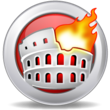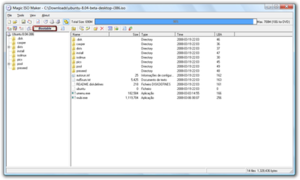
ISO 9660 is a file system for optical disc media. The file system is an international standard available from the International Organization for Standardization (ISO). Since the specification is available for anybody to purchase, implementations have been written for many operating systems.
Universal Disk Format (UDF) is an open, vendor-neutral file system for computer data storage for a broad range of media. In practice, it has been most widely used for DVDs and newer optical disc formats, supplanting ISO 9660. Due to its design, it is very well suited to incremental updates on both write-once and re-writable optical media. UDF was developed and maintained by the Optical Storage Technology Association (OSTA).
A disk image is a snapshot of a storage device's structure and data typically stored in one or more computer files on another storage device.

A live CD is a complete bootable computer installation including operating system which runs directly from a CD-ROM or similar storage device into a computer's memory, rather than loading from a hard disk drive. A live CD allows users to run an operating system for any purpose without installing it or making any changes to the computer's configuration. Live CDs can run on a computer without secondary storage, such as a hard disk drive, or with a corrupted hard disk drive or file system, allowing data recovery.
An optical disc image is a disk image that contains everything that would be written to an optical disc, disk sector by disc sector, including the optical disc file system. ISO images contain the binary image of an optical media file system, including the data in its files in binary format, copied exactly as they were stored on the disc. The data inside the ISO image will be structured according to the file system that was used on the optical disc from which it was created.

Optical disc authoring, including CD, DVD, and Blu-ray Disc authoring, is the process of assembling source material—video, audio or other data—into the proper logical volume format to then be recorded ("burned") onto an optical disc. This act is sometimes done illegally, by pirating copyrighted material without permission from the original artists.

K3b is a CD, DVD and Blu-ray authoring application by KDE for Unix-like computer operating systems. It provides a graphical user interface to perform most CD/DVD burning tasks like creating an Audio CD from a set of audio files or copying a CD/DVD, as well as more advanced tasks such as burning eMoviX CD/DVDs. It can also perform direct disc-to-disc copies. The program has many default settings which can be customized by more experienced users. The actual disc recording in K3b is done by the command line utilities cdrecord or cdrkit, cdrdao, and growisofs. As of version 1.0, K3b features a built-in DVD ripper.

Alcohol 120% is a disk image emulator and disc burning software for Microsoft Windows developed by Alcohol Soft. An edition named Alcohol 52% is also offered which lacks the burning engine. The software can create image files from a source CD/DVD/Blu-ray, as well as mount them in virtual drives, all in the proprietary Media Descriptor File format; images in this format consist of a pair of .mds and .mdf files.

CloneDVD is a proprietary DVD cloning software, developed by Elaborate Bytes, that can be used to make backup copies of any DVD movie not copy-protected. The program is able to transcode a dual layer DVD movie to fit it onto a DVD-R, DVD+R or DVD+R DL disc. Users also have the choice to strip audio streams, subtitles and chapters. This is called customize. For example, users can edit and delete certain parts of a DVD that they don't want burned, such as the main menu, bonus features, commentary, or certain scenes from the actual DVD. By moving a quality bar the user can make the DVD fit its target medium.
A cue sheet, or cue file, is a metadata file which describes how the tracks of a CD or DVD are laid out. Cue sheets are stored as plain text files and commonly have a .cue filename extension. CDRWIN first introduced cue sheets, which are now supported by many optical disc authoring applications and media players.
IMG, in computing, refers to binary files with the .img filename extension that store raw disk images of floppy disks, hard drives, and optical discs or a bitmap image – .img.
A CloneCD Control File is a text descriptor with the extension .ccd used by CloneCD to store the subcode data of a CD/DVD image. These files need to be combined with an image file to be burned. It may also come with a subchannel file.
Direct Access Archive, or DAA, is a proprietary file format developed by PowerISO Computing for disk image files. The format supports features such as compression, password protection, and splitting to multiple volumes. Popular Windows disk image mounting programs such as Alcohol 120% and Daemon Tools currently do not support the mounting of DAA images; Linux and BSD also do not support mounting images of this kind.

CDemu is a free and open-source virtual drive software, designed to emulate an optical drive and optical disc on the Linux operating system.
An NRG file is a proprietary optical disc image file format originally created by Nero AG for the Nero Burning ROM utility. It is used to store disc images. Other than Nero Burning ROM, however, a variety of software titles can use these image files. For example, Alcohol 120%, or Daemon Tools can mount NRG files onto virtual drives for reading.
Media Descriptor File (MDF) is a proprietary disc image file format developed for Alcohol 120%, an optical disc authoring program. Daemon Tools, CDemu, MagicISO, PowerDVD, and WinCDEmu can also read the MDF format. A disc image is a computer file replica of the computer files and file system of an optical disc.

A CD-ROM is a type of read-only memory consisting of a pre-pressed optical compact disc that contains data computers can read—but not write or erase—CD-ROMs. Some CDs, called enhanced CDs, hold both computer data and audio with the latter capable of being played on a CD player, while data is only usable on a computer.
Notable software applications that can access or manipulate disk image files are as follows, comparing their disk image handling features.

AcetoneISO is a free and open-source virtual drive software to mount and manage image files. Its goals are to be simple, intuitive and stable. Written in Qt, this software is meant for all those people looking for a "Daemon Tools for Linux". However, AcetoneISO does not emulate any copy protection while mounting.

Nero Burning ROM, commonly called Nero, is an optical disc authoring program from Nero AG. The software is part of the Nero Multimedia Suite but is also available as a stand-alone product. It is used for burning and copying optical media such as CDs, DVDs, and Blu-ray disks. The program also supports the label printing technologies LightScribe and LabelFlash, and can be used to convert audio files into other audio formats.







